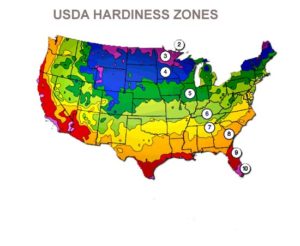It is important to know what planting (growing) zone you are in.
If a plant is listed as hardy to zone 3, for example, then it can be grown in zones 3-10. If the hardiness is listed, for example, as zones 3-8, then it can be grown in zones 3-8.
Some gardeners will “push” the limits and may have success in growing some plants outside of the recommended zone. For example, a shrub listed as hardy to zone 5 might succeed in zone 4 if grown in a sheltered location or given extra protection over winter. Note that this does not apply to the other end of the spectrum. If a plant is listed, as an example, zones 3-8, then success in a higher zone is unlikely. Most trees, shrubs, and perennials require a winter dormancy period and some require a certain number of hours of winter chill or freezing temperatures or they will not flower. Lilacs are a good example. Beyond zone 8, blooms will be sparse at best and they will not bloom at all in zone 10. Another factor can be if the plant can tolerate the summer heat of a higher zone number. Note that we will not guarantee plants grown outside of the USDA recommended zone.

